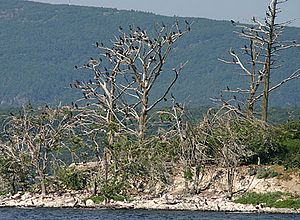Cormorant Management on Hold?

Dozens of Cormorants perched in dead trees. Image: theoutdoorgazette.com
A federal court has ruled that the authority under which hundreds of thousands of double-crested cormorants around the country are killed each year was illegally issued. The ruling calls into question state and federal authority to manage cormorants on Lake Champlain. The court found that the U.S. Fish and Wildlife Service (USFWS) clearly violated the National Environmental Policy Act (NEPA) when they authorized taking cormorants in 24 states east of the Mississippi River without current data or adequate scientific analysis to back up their decision.
USFWS allowed open-ended approval for “lethal removal” of double-crested cormorants until 2019 if they were predating fish, thus removing the birds from protection under the Migratory Bird Treaty Act. The approval was challenged by Public Employees for Environmental Responsibility (PEER) a group that protects government-employed whistleblowers.
U.S. District Judge John Bates issued the ruling. "Rather than take a 'hard look' at the impacts on cormorant populations if the orders were extended through 2019, FWS simply lifted the findings from its 2009 [environmental assessment] regarding the expected impact of extending the orders through 2014," Bates wrote. The judge found it "hard to imagine a 'softer' look."
"Indeed, it defies common sense simply to assume that the population of double-crested cormorants has remained unchanged since 2009 or that the predicted impact of extending the orders would be exactly the same in 2014 as it was in 2009, when five years of 'taking' have occurred in the interim," Bates wrote.
The court stopped short of immediately ending depradation orders issued by USFWS but called for additional briefings on an appropriate “remediation plan”. Impacts of the court decision on cormorant management plans for Lake Champlain are unclear at this time.
